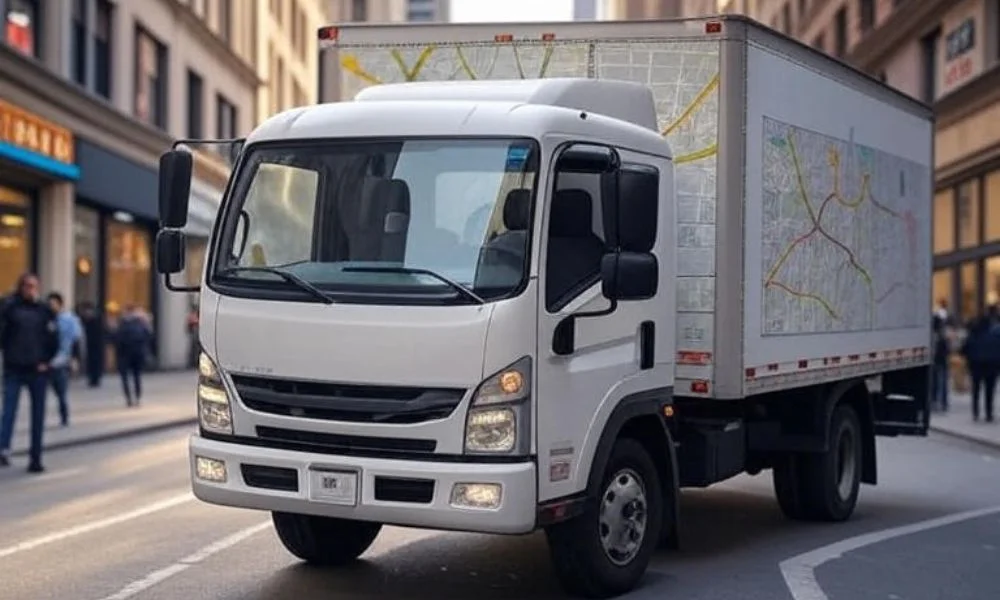Artificial Intelligence
Tools & Comparisons: Best Route Optimization APIs with AI (Google, Routific, OptimoRoute)
Looking for the best AI route optimization APIs? Discover how Google Maps, Routific, and OptimoRoute improve delivery speed, planning, and efficiency.

I aim to be smarter and save time when making my routings and work on them in a time-saving manner. That is why I investigated the strength of the AI route optimization and its impacts in transforming the delivery, travelling and logistic management system in the United States.
Definition:
The process of obtaining a route towards multiple stops or destinations ensuring minimum efforts to be put in is known as route optimization.
At this point, AI goes a step beyond that. It teaches itself with traffic patterns, delivery delays and behavior of customer to optimize plans automatically. I have observed the amount of time and petrol it saves with proper use. It resembles having a clever secretary that never goes to sleep.
In this post, I’ll walk you through some of the best route optimization APIs with AI, including Google, Routific, and OptimoRoute. I will contrast their features, advantages as well as their best application. In development of a delivery application or in your logistics business, you will have an insight on what to expect and what API to use in running your business successfully.
Understanding Route Optimization and AI:
I apply route optimization programs when I need to reduce operating expenses and deliver goods and services without using much time and fuel. It assists me to route a course of action of maximizing my destinations without getting lost as well as getting to my destination in a timely manner. This process is important no matter whether I drive across town or supervise several drivers in distinct places.
AI does the same but makes it smarter. it analyses live traffic, weather, and delivery history, to propose quick and safe route within a second. I can see the fact that AI can change the plans and adapt to changes on the road before problems occur.
This planning is in use in many industries already through use of AI. It is used by logistics companies to satisfy the short delivery windows. It is used by E-commerce business to curb the last-mile delays. Field service departments rely on it to ensure its technicians remain punctual. These tools are no longer optional and they’re now a must for staying competitive in the United States.
Key Features to Look for in a Route Optimization API:
When I choose a route optimization API, I first check how well it handles real-time traffic updates. Routes lose their efficiency as they cannot be maintained with real-time information in case of unforeseen congestions or delays. Good APIs observe the roads and adapt fast.
The multi-stop planning is also required by me as I seldom have one destination. An intelligent API can calculate the optimal route of stops within a few seconds. It conserves fuel, eliminates confusion and enhances the delivery timing.
Another feature that I always look at is dynamic re-routing. In case something is altered on the way, the API is supposed to change immediately without a manual intervention or time lag.
Rules of being a driver are also important. I seek the justification of driver and vehicle restrictions like the maximum hours, size of vehicles, and breaks. These guidelines can assist in a fine and burnout.
The scalability and documentation of API is a big deal in long-term use. I would like to have an API that performs on ten deliveries or ten thousand and includes developer guidelines.
Lastly, analytics and reporting give me the greater picture. They allow me to monitor success in deliveries, performance of the routes, and how these might be improved with time. The icing on the cake is ease of integration- I do not want to have to adopt a different set of tools to get it to work.
Google Maps Route Optimization API:
I also began with Google maps API since it is straightforward, easy to use and can be used in its default state to provide simple routing requirements. It is an intelligent application that supports route planning using real-life traffic and estimating travel times. Google Maps I have used before on my phone; it seems like an expanded service to add via an API on apps.
The API of Google links to the Google Maps Platform. That is why I can easily find such tools as Directions, Routes, and Distance Matrix. I can be creating a delivery tool or a travel app, this API provides stable and adjustable routing capabilities.
Key Features That Make Google Maps Stand Out:
I have witnessed the quality of how Google lets people know of the real time condition of traffic. It provides up-to-date directions that work out information on roads in real time, and my plans are in line and practical.
The Distance Matrix API obtains traveling time among several locations. I apply it to sort and plan the optimal delivery sequence in the real time.
Through Routes API and Directions API, I obtain the route-wise directions and recommended routes. Such tools provide in-built assistance on traffic-based modifications and avoidance of tolls.
One more advantage is its predictive travel times. It calculates the time that a route would take later during the day by use of former trends. That assists in smarter scheduling to prevent the delays in the future.
Advantages I Get from Google Maps API:
Their API operates in all parts of the world, and this is ideal in the case of U.S-based organizations that have international expansion in mind. Worldwide and accurateness implies that I can trust it everywhere.
I appreciate the level of its reliability and familiarity. The majority of developers are already familiar with the feel of Google Maps, and on a much more advanced level.
The deployment of Google is fast. I used the API in my project in a few hours because of great documentation and a community that was helpful.
limitations of Google Maps API:
Although it has its advantages, I observed that it does not have logic in delivery means. It does not provide such features as driver shifts, depot returns, or time windows.
Cost is also an issue when the scale occurs. It is cheap on small projects, but heavy usage and huge fleets will soon add to the bill.
Best Use Cases for Google Maps API:
I would suggest using this API in general cases of navigation as there is no requirement of complex logistics. It is outstanding at mapping and tracking the ETAs.
It is also good on planning travel routes, such as trip builders or local tourism apps that give instruction to people on their way through a city or monument.
If you run a small delivery business with a few stops per day, this API might be all you need. It offers speed, ease, and precision.
Routific API:
I had to find a smarter delivery management and handling of local routes, and Routific became one of my favorites. It is more than a mapping tool it is designed to take logistics and delivery into consideration. This is why it is used daily by the companies providing last-mile delivery and field services in the U.S.
Routific is designed to serve companies that take action and go regularly. It provides AI route optimization by considering your drivers, time windows and customer preferences. I consider it concentrated, adaptive and simple when it comes to delivery in the real world.
Features That Make Routific a Delivery Powerhouse:
I have used Routific to handle intelligent delivery windows that leave my customers satisfied and my drivers on time. It allows me to specify specific time frames of each stop.
It is also capable of enforcing driver limits as well as favorability practices including break durations, route restriction and vehicle capacity. This averts overtime and burnout.
Real time route change is another game changer. I will be able to deal with plans dynamically in case of cancellations of a delivery or when traffic crawls without prior notice.
To crown it all, I am in love with its customer notification system. It also helps to remind the people of their order getting closes or being delayed- letting me out of constant calls and emails.
Why I Prefer Routific for Delivery Planning?
Routific is made specifically in logistics and delivery so I would not have to make it scratch. It is plug and play.
The AI optimisation is easy and potent. It computes the quickest time in seconds, even when I have tens of stops.
I also like the fact that the constraints are very customisable. I can also adjust it to fit various drivers, geographical areas, and customer regulations at ease.
Limits to Routific:
When you are not in the delivery, Routific might be a bit too much. It can be used only in delivery applications, not in the travel plan where a field reporter is required.
Also, the rate system is grounded on the number of stops. It is a costly venture when you have a huge volume of small orders.
When to Use Routific API?
Routific is ideal to serve last mile delivery, where time and pace is the most important factor. I have applied it to reduce the delivery time by half.
It is also effective in the local courier business which operates in heavy traffic locations within the U.S. cities.
In case your business involves groceries or meal deliveries, Routific can ensure that you are efficient in your operations particularly with regards to customer satisfaction.
OptimoRoute API:
I discovered OptimoRoute when I had to work with a higher number of delivery staff and much more delivery volumes. It is an advanced API that is AI-based and does more than navigate. I discovered that it would be helpful in long term planning as well as in-time changes even over several days of service.
This API allows business that requires accuracy, versatility, and analytics. I can arrange weekly schedules, or even monitor dozens of drivers at the same time, and OptimoRoute has the depth and control I require.
Entreprise Ready Features:
I like very much its weekly planning system and real-time tracking system. It allows me to pre-scheduled times and, at the same time, be able to react immediately when there are alterations.
Through optimization of order and vehicle capacity, I will be able to assign the correct load with the correct driver. That makes the routes efficient and preventing overpacking.
I prefer to use route history and analytics. It enables me to plan better in the future reflecting on the previous delivery times and errors.
The options of the proof of delivery are an immense bonus. When confirming deliveries, I rely on photo capture and digital signatures, which brings in a sense of professionalism and credibility.
What Makes OptimoRoute Stand Out?
I believe it is great to use fleet and complicated scheduling especially in companies that receive high volumes and have deadlines to meet.
It is also amazing since it facilitates delivery and field workforce. I apply it on technicians, service calls as well as multi stop repair schedules.
The most is that it is scalable. Because I have ten drivers or even 100 fore no matter how much the number increases, it is constant with my business.
Where OptimoRoute Might Not Fit Every Team?
I will be frank – the platform is steeper to learn. I found it a bit complicated in learning than easier APIs.
Moreover, it might need a tailored system in case you operate a small facility. It is designed around teams requiring scale both in say structure and flexibility.
Best Use Cases for OptimoRoute API:
When I am setting up multi-day service jobs such as HVAC installations or visiting to do work, OptimoRoute makes it all clear and simple to the end.
It works well with healthcare and technician visits, where time slots and delicate activities are the most important.
When it comes to large deliveries such as furniture, large orders, or subscription boxes, the application will help better organize paths and resources.
Side-by-Side Feature Comparison Table:
| Feature | Google Maps API | Routific | OptimoRoute |
|---|---|---|---|
| Real-Time Traffic | ✅ Yes | ✅ Yes | ✅ Yes |
| Multi-Stop Optimization | ⚠️ Manual Setup Needed | ✅ Automatic | ✅ Automatic |
| Driver Constraints | ❌ Not Supported | ✅ Supported | ✅ Supported |
| Route Tracking | ⚠️ Requires Extra Services | ✅ Built-In | ✅ Built-In |
| Ideal for Logistics | ⚠️ Basic Use Only | ✅ Tailored for Logistics | ✅ Logistics + Field Teams |
| Pricing Flexibility | ⚠️ Usage-Based Pricing | ✅ Flexible Plans | ✅ Flexible Plans |
| Ease of Use | ✅ Very Easy | ✅ User-Friendly | ⚠️ Slight Learning Curve |
AI in Route Optimization: What’s Under the Hood?
When I rely on route optimization APIs, I’m actually using complex AI tools working behind the scenes in real time. Machine learning that uses traffic history, the type of the road, and the time of the day to predict ETAs has become one of the most powerful features.
It is also AI that does the clustering and the prioritization of the stops. It is the one which learns to combine close destinations with each other and which determines which stops to visit most effective.
The most impressive thing is how these systems modify in real-time using live data. The AI keeps my route updated even before I ask when there is a traffic jam, an incident, or a hold up.
Choosing the Right API: What to Consider:
When I pick a route optimization API, I start by evaluating my business size and delivery volume. A smaller crew requires straightforwardness, a bigger fleet requires size.
I also consider the budget and pricing model with proper thought. Long-term costs are influenced by the usage or by the number of stops charged by some APIs.
The other major determinant is the degree of customization. I would always ask: Can it employ time windows, capacity constraint or driver rests?
Lastly, I evaluate technical resources and integration support. In the case when I am collaborating with a small dev team, I require great docs and excellent customer support.
Recommendations by Business Type:
I have discovered these are the best things to do according to the type of company and its challenges on a daily basis:
- Small or Medium-Sized Businesses: I would suggest Routific as it is narrowed down, low cost, and ready-to-install by teams with no to little setup.
- General App Developers: Google Maps API is ideal when you require solid routing of apps such as traveling planners or just basic navigation apps.
- Fleet Management & Enterprise: I rely on OptimoRoute in case of big scales. It is able to deal with the crammed workloads, heavy schedules, and multi-service crews.
Future Trends in AI-Powered Route Optimization:
AI is catching up and I believe that the route planning process is going to change in the upcoming years. Among the trending aspects is the incorporation of the autonomous vehicles- paths that are synchronized with autonomous delivery vans.
Naturally, we will experience more predictive maintenance and delivery success scoring. We will learn about maintenance requirements of vehicles ahead of time and what may go wrong with an order even before they do!
Carbon footprint optimization is another large transition. My preference is to minimize emissions and the future APIs will present green paths without the need to select them.
I am also witnessing the popularity of crowdsourcing delivery strategies. In the near future, AI might regulate the work of freelance drivers in real-time to satisfy the immediate demand.
Conclusion:
Route optimization APIs with AI are changing the way I work. Google Maps as well as Routific or OptimoRoute have tools that serve different purposes.
Google Maps is a very good start in case you want something simple and worldwide. Routific is exceptional in delivery power. And when it comes to large-scale planning, OptimoRoute satisfies all my needs and adds even more.
AI will continue to get smarter only in the future and will make every mile more productive. I would recommend a free trial or demo, you will soon realize how much time and stress you can get back.
-

 Artificial Intelligence8 months ago
Artificial Intelligence8 months agoWhat is Artificial Intelligence? A Comprehensive Guide for Businesses and Enthusiasts
-

 Artificial Intelligence6 months ago
Artificial Intelligence6 months agoHow to Use Grok AI: A Complete Guide
-

 Artificial Intelligence8 months ago
Artificial Intelligence8 months agoUnlocking the Power of Artificial Intelligence Tools
-

 Artificial Intelligence7 months ago
Artificial Intelligence7 months agoWhat is DeepSeek? Revolutionizing AI with Cutting-Edge Solutions
-

 Artificial Intelligence3 months ago
Artificial Intelligence3 months agoAI Technologies in Warehouse Automation:
-

 Artificial Intelligence4 months ago
Artificial Intelligence4 months agoMeta’s AI Push: The Standalone Assistant App Set to Rival ChatGPT
-

 Artificial Intelligence3 months ago
Artificial Intelligence3 months agoHow Artificial Intelligence is Revolutionizing Logistics:
-

 Artificial Intelligence3 months ago
Artificial Intelligence3 months agoPredictive Analytics for Demand Forecasting:


